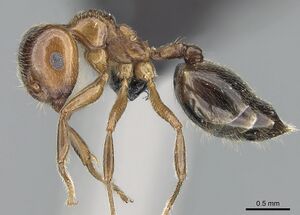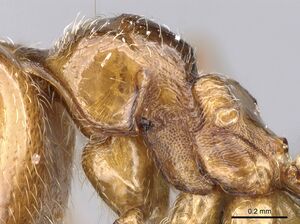Crematogaster tsisitsilo
| Crematogaster tsisitsilo | |
|---|---|

| |
| Scientific classification | |
| Kingdom: | Animalia |
| Phylum: | Arthropoda |
| Class: | Insecta |
| Order: | Hymenoptera |
| Family: | Formicidae |
| Subfamily: | Myrmicinae |
| Tribe: | Crematogastrini |
| Genus: | Crematogaster |
| Species: | C. tsisitsilo |
| Binomial name | |
| Crematogaster tsisitsilo Blaimer, 2013 | |
Crematogaster tsisitsilo is found mainly in dry forest habitats in north-western Madagascar. Disjunct from this distribution, the species has also been found in the Foret d’Antsahabe, a dry forest in the far northern tip of Madagascar. Sympatry with the C. kelleri-group exists only with Crematogaster kelleri. Not much can be said about the natural history of this species, since most collections were composed of foraging workers. One collection has been made from a carton nest, but the generality of this habit needs to be confirmed with additional data. (Blaimer and Fisher 2013)
Identification
Blaimer and Fisher (2013) - Crematogaster tsisitsilo is uniquely recognizable from all other Crematogaster species in Madagascar by the lack of propodeal spines and the absence of a median impression on the postpetiole. Workers of this species vary greatly in size, with the smallest specimens being found at the southernmost edge of the distribution (P.N. Bemaraha and Beanka).
Keys including this Species
Distribution
Latitudinal Distribution Pattern
Latitudinal Range: -13.21167° to -19.14194°.
| North Temperate |
North Subtropical |
Tropical | South Subtropical |
South Temperate |
- Source: AntMaps
Distribution based on Regional Taxon Lists
Malagasy Region: Madagascar (type locality).
Distribution based on AntMaps
Distribution based on AntWeb specimens
Check data from AntWeb
Countries Occupied
| Number of countries occupied by this species based on AntWiki Regional Taxon Lists. In general, fewer countries occupied indicates a narrower range, while more countries indicates a more widespread species. |

|
Estimated Abundance
| Relative abundance based on number of AntMaps records per species (this species within the purple bar). Fewer records (to the left) indicates a less abundant/encountered species while more records (to the right) indicates more abundant/encountered species. |

|
Biology
Castes
Worker
Images from AntWeb
    
| |
| Worker. Specimen code casent0317689. Photographer Estella Ortega, uploaded by California Academy of Sciences. | Owned by CAS, San Francisco, CA, USA. |
    
| |
| Holotype of Crematogaster tsisitsilo. Worker. Specimen code casent0317686. Photographer Estella Ortega, uploaded by California Academy of Sciences. | Owned by CAS, San Francisco, CA, USA. |
       
| |
| Worker. Specimen code casent0120279. Photographer Estella Ortega, uploaded by California Academy of Sciences. | Owned by CAS, San Francisco, CA, USA. |
Male
Images from AntWeb
      
| |
| Male (alate). Specimen code casent0317695. Photographer Estella Ortega, uploaded by California Academy of Sciences. | Owned by CAS, San Francisco, CA, USA. |
Nomenclature
The following information is derived from Barry Bolton's Online Catalogue of the Ants of the World.
- tsisitsilo. Crematogaster tsisitsilo Blaimer, in Blaimer & Fisher, 2013a: 26, figs. 30, 31 (w.m.) MADAGASCAR.
- Type-material: holotype worker, 4 paratype workers.
- Type-locality: holotype Madagascar: Majunga, Ambondromamy, 64 m., 16°26.25’S, 47°09.45’E, 7.ii.2007, BLF16530, urban garden (B.L. Fisher, et al.); paratypes with same data.
- Type-depositories: CASC (holotype); MCZC, MHNG, SAMC, UCDC (paratypes).
- Distribution: Madagascar.
Unless otherwise noted the text for the remainder of this section is reported from the publication that includes the original description.
Description
Worker
(n= 20). HW 0.6621.03 [0.97]; HL 0.6220.91 [0.89]; EL 0.1320.23 [0.21]; SL 0.4620.67 [0.66]; WL 0.6220.98 [0.95]; SPL 0.00; PTH 0.1220.21 [0.21]; PTL 0.1820.31 [0.28]; PTW 0.2120.32 [0.32]; PPL 0.1220.20 [0.17]; PPW 0.1820.30 [0.30]; LHT 0.4220.73 [0.69]; CI 1.0721.15 [1.09]; OI 0.2120.27 [0.23]; SI 0.7320.82 [0.75]; SPI 0.00; PTHI 0.6520.83 [0.76]; PTWI 0.9921.29 [1.15]; PPI 1.2921.81 [1.81]; LBI 1.3021.63 [1.37].
Very small to medium size (HW 0.6621.03, WL 0.6220.98).
Masticatory margin of mandibles with four teeth; head shape quadrate, mostly as long as wide (CI 1.07–1.15); posterior margin of head in full face view laterally rounded, subangular or angular; occipital carinae indistinct; antennal scapes not, or just reaching head margin; midline of eyes situated at midline of head in full face view; eyes fairly large (OI 0.21–0.27) and moderately protruding.
Pronotum laterally subangular; promesonotal suture distinct or indistinct; mesonotum to varying degree raised over pronotum, and a minute median tubercule is present; mesonotum usually with a rounded dorsal and a short posterior face; mesonotum rounded dorsolaterally; in lateral view outline of promesonotum appears as one convex hump; posterior face of mesonotum slopes steeply into metanotal groove; metanotal groove fairly deep, much constricted and bordered by lateral carinae; propodeal spines absent; propodeal spiracles large; dorsal face of propodeum very short and convex, distinctly set off from posterior face, laterally expanded to about twice the width of metanotal groove; posterior face of propodeum convex and steeply sloping; petiole in dorsal view oval, dorsolaterally rounded and without posterolateral tubercules or denticles; subpetiolar process absent; postpetiole wider than long, rounded, not distinctly bilobed, with at most a faint median impression posteriorly; subpostpetiolar process absent.
Sculpture reduced overall; head shiny to aciculate; mesosoma dorsally shiny and aciculate; propleuron aciculate, meso- and metapleuron mostly reticulate; dorsal face of propodeum aciculate to reticulate, posterior face shiny; dorsal face of petiole shiny; helcium aciculate; postpetiole dorsally aciculate; lateral and ventral face of petiole and postpetiole feebly reticulate. Face usually with four to eight erect, longer setae, and abundant shorter erect to subdecumbent pubescence; usually two to four erect humeral setae present on promesonotum, otherwise promesonotum dorsally with regular subdecumbent pubescence; petiole and postpetiole with a pair of short erect setae posterolaterally, and shorter suberect, decumbent or appressed pubescence; abdominal tergites four to seven with very sparse short erect pilosity that is more abundant on sternites four to seven, and dense appressed to decumbent pubescence throughout. Color yellowish-brown to dark brown.
Male
(n =1). HW 0.67, HL 0.46, EL 0.28, SL 0.11, MSNW 0.76, MSNL 0.72, WL 1.30, SPL 0.00, PTH 0.17, PTL 0.20, PTW 0.23, PPL 0.15, PPW 0.27, LHT 0.64, CI 1.46, OI 0.62, SI 0.24, MSNI 1.06, SPI 0.00, PTHI 0.82, PTWI 1.14, PPI 1.80, LBI 2.02.
Small (HW 0.67, WL 1.30). Masticatory margin of mandibles with three teeth; clypeus only moderately protruding; eyes large (OI 0.62) and protruding, midline of eyes situated well below midline of head, almost extending to clypeal margin; antennae 12-segmented, scapes very short (SI 0.24); head much wider than long (CI 1.46); in full face view ocellar triangle situated at posterior head margin and elevated with respect to rest of face; occipital carinae distinct. Mesosoma compact (MSNI 1.06, WL 1.30); mesoscutum in dorsal view as wide as long, posterolaterally constricted just before axillae; axillae tranversely compressed and narrow; scutellum in dorsal view broadly tapering from anterior to posterior end, dorsoposterior portion rounded; metanotum not distinctly protruding from below scutellum; dorsal face of propodeum very short, posterior face longitudinally convex; propodeal spines absent; petiole in dorsal view oval and laterally rounded, in lateral view petiole tapers greatly anteriorly; subpetiolar process absent; postpetiole lacking median impression; wings with a brownish hue.
Head sculpture shiny, rugulose within ocellar triangle; clypeus longitudinally with one short median and a pair of lateral carinae, and two short transverse carinae on each side; mesoscutum and scutellum shiny, propodeum longitudinally carinulate; petiole and postpetiole rugulose-shiny; scattered short erect pilosity on face; mesoscutum with scattered short erect pilosity; scutellum dorsolaterally with longer erect pilosity; petiole and postpetiole with longer dorsoposterior setae, and abundant erect pilosity dorsally and laterally; abdominal tergites and sternites four to seven with abundant short suberect pubescence, longer erect pilosity lacking. Color brown.
Type Material
MADAGASCAR: Mahajanga: Ambondromamy: -16.43750, 47.15750, 64 m, urban/garden. Holotype worker: pinned, CASENT0317686, BLF16530, on low vegetation [imaged on Antweb]; original locality label: MADG’R: Majunga: Ambondromamy:, 64 m, 07.ii.2007, 16u26.259S, 47u09.459E, urban/garden, Fisher et al., BLF16530; deposited at California Academy of Sciences. Four paratype workers, pinned, same collection and locality data as holotype. #1: CASENT0317684, deposited at South African Museum; #2: CASENT0317685, deposited at Musee d'Histoire Naturelle Genève. #3: CASENT0317687, deposited at Museum of Comparative Zoology. #4: CASENT0317688, deposited at University of California, Davis.
Etymology
This species is named for its complete lack of propodeal spines, as ‘‘tsisitsilo’’ means ‘‘no spines’’ in Malagasy. This name is to be treated as noun in apposition.
References
- Blaimer, B.B., Fisher, B.L. 2013. Taxonomy of the Crematogaster degeeri-species-assemblage in the Malagasy region (Hymenoptera: Formicidae). European Journal of Taxonomy 51: 1-64 (doi:10.5852/ejt.2013.51).
References based on Global Ant Biodiversity Informatics
- Blaimer B. B., B. L. Fisher. 2013. How much variation can one ant species hold? Species delimitation in the Crematogaster kelleri-group in Madagascar. PLoS ONE 8(7): e68082. doi:10.1371/journal.pone.0068082
- Blaimer B. B., B. L. Fisher. 2013. How much variation can one ant species hold? Species delimitation in the Crematogaster kelleri-group in Madagascar. PLoS ONE 8(7): e68082. doi:10.1371/journal.pone.0068284
- Blaimer B. B., B. L. Fisher. 2013. How much variation can one ant species hold? Species delimitation in the Crematogaster kelleri-group in Madagascar. PLoS ONE 8(7): e68082. doi:10.1371/journal.pone.0068288
- Blaimer B. B., B. L. Fisher. 2013. How much variation can one ant species hold? Species delimitation in the Crematogaster kelleri-group in Madagascar. PLoS ONE 8(7): e68082. doi:10.1371/journal.pone.0068289
- Blaimer B. B., B. L. Fisher. 2013. How much variation can one ant species hold? Species delimitation in the Crematogaster kelleri-group in Madagascar. PLoS ONE 8(7): e68082. doi:10.1371/journal.pone.0068290
- Blaimer B. B., B. L. Fisher. 2013. How much variation can one ant species hold? Species delimitation in the Crematogaster kelleri-group in Madagascar. PLoS ONE 8(7): e68082. doi:10.1371/journal.pone.0068291

